Fujifilm's GFX 100 packs a monstrous 102MP sensor and insanely high-end specs
Including a whopping 3.78 million phase-detect autofocus points
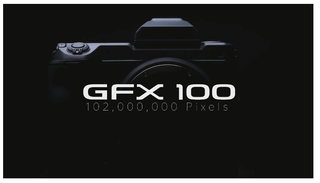
The first time we heard about a 100MP medium format camera from Fujifilm was back in September of last year, at Photokina 2018. Since then, the rumor mill has been rife with whispers of this high-resolution camera, but they can all now be put to rest.
The Fujifilm GFX 100 has officially debuted, packing a mammoth 102MP backside-illuminated (BSI) CMOS sensor working alongside a speedy X-Processor 4 image processor, which has previously starred in Fujifilm's X-T30 snapper. This marriage, Fujifilm says, helps the GFX 100S achieve autofocus (AF) speeds that are twice as fast the GFX 50S.
In fact, given the sensor is 70% larger than a 35mm full-frame counterpart, Fujifilm prefers to call the GFX 100 a "large format" camera rather than a medium format one.
The sensor, however, isn't the only part of the GFX 100 that comes with a big number. The new pro shooter includes with some jaw-dropping specs that, combined, promise all-round top-notch performance.
It's all high-end from here
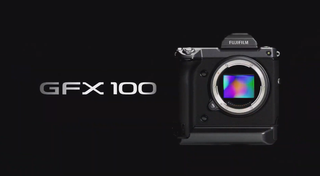
The high-speed autofocus performance – capable of locking in on a subject in 0.05 seconds – is matched by a whopping 3.78 million phase-detect AF pixels across the entire surface of the sensor and offering 100% coverage of the frame. This also makes the GFX 100 perform better in low-light conditions than both the GFX 50S and the GFX 50R.
Fujifilm has also improved its face- and pupil-detection technology and, the company claims, the GFX 100 will be able to track eyes even when the subject is turning away from the camera or is partially obscured by another object. While it does pick up multiple subjects, it is possible to choose one face in the crowd to focus on.
However, the headline improvement to the GFX series is the inclusion of in-body image stabilization (IBIS) in the GFX 100. Its built-in five-axis image stabilization offers what Fujifilm claims to be a 5.5-stop shutter speed advantage.
Get daily insight, inspiration and deals in your inbox
Sign up for breaking news, reviews, opinion, top tech deals, and more.
This is good news for both still and video shooters using the camera handheld, although the ability to shoot 4K video at up to 30fps will excite videographers. Recording to an SD card (there are two card slots here) is 10-bit 4:2:0, while using the HDMI port achieves a 10-bit 4:2:2 output.
Another highlight for the videographer is the addition of the ETERNA Film Simulation mode used for the first time in a GFX series camera.
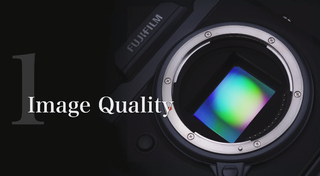
It's all crystal clear
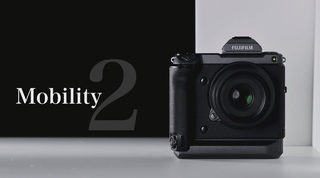
While the design of the camera is rather minimalistic, lacking the usual dials and buttons we're familiar with on other Fujifilm cameras, the GFX 100 boasts one of the best electronic viewfinders in the business. The newly developed 5.76 million-dot organic EL electronic viewfinder offers a magnification of 0.86x and a refresh rate of 86fps.
Also like the GFX 50S, this new high-res snapper boasts a 3.2-inch rear display that tilts in three directions, but there's also an additional 1.8-inch top plate LCD that's making its debut here. That top plate can be used as a "virtual dial mode" to display dials for adjusting settings like aperture, ISO and shutter speed, but it can also be set to show the histogram.
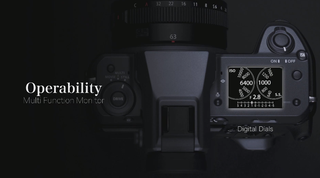
Another new feature is the new Smooth Skin Effect, which automatically retouches skin in-camera to smooth out the high level of details the 100MP sensor can capture.
The GFX 100 is significantly larger than its predecessors in the GFX 50 series, and weighs in at approximately 1,400g (or 3.1 pounds), including two batteries, a memory card and the EVF slid into place.
The Fujifilm GFX 100 will begin shipping in June, with a slightly eye-watering price tag of $9,999 (about £7,920 / AU$14,450) before tax.

While she's happiest with a camera in her hand, Sharmishta's main priority is being TechRadar's APAC Managing Editor, looking after the day-to-day functioning of the Australian, New Zealand and Singapore editions of the site, steering everything from news and reviews to ecommerce content like deals and coupon codes. While she loves reviewing cameras and lenses when she can, she's also an avid reader and has become quite the expert on ereaders and E Ink writing tablets, having appeared on Singaporean radio to talk about these underrated devices. Other than her duties at TechRadar, she's also the Managing Editor of the Australian edition of Digital Camera World, and writes for Tom's Guide and T3.